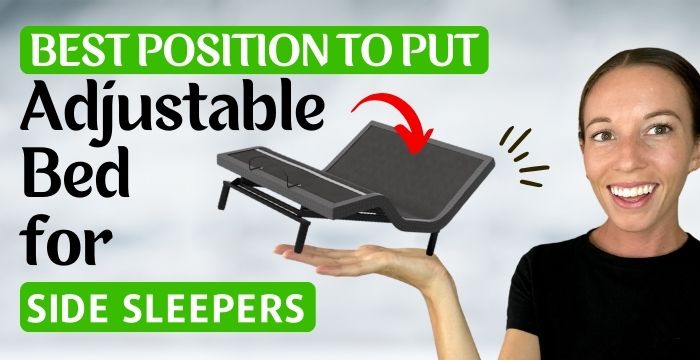Side sleepers, we get it. It’s not just about drifting off; it’s an art form. The perfect curl, the leg stretch, the quest for the ideal nook where the shoulder rests. While adjustable beds have been our trusty canvas, the masterpiece is in the positioning. And just like a masterpiece doesn’t paint itself, the perfect sleep doesn’t just… well, happen. So, how do you fine-tune this bed to be your personal sleep symphony conductor? What’s the best position to put an adjustable bed for side sleepers? Read on, and find out exactly that and much more!
What’s the best position to put adjustable bed for side sleepers
For side sleepers, the most recommended position on an adjustable bed is the Zero Gravity position.
This position elevates both the head and legs slightly, reducing pressure points and promoting better blood circulation, which is particularly beneficial for side sleepers.
Additionally, placing a pillow between the knees while in this position can further enhance spinal alignment and comfort.
Psst! if you’re looking for the best sheets for adjustable beds – you know, the ones that actually stay put – I recommend the specially designed Quickzip Split King Adjustable bed sheets and LANE LINEN Split King Sheets. Alternatively, if you’re on a budget, get these affordable sheets with deep pockets.
Or if you’re looking for an adjustable bed, get the highly rated Saatva Adjustable Bed Base or Amerisleep. Go for the affordable Lucid L300 Adjustable Bed if you’re on a tight budget.
How does the zero-gravity position benefit side sleepers?
- Reduced Spinal Pressure: The zero-gravity position helps maintain the natural curvature of the spine, minimizing strain on the vertebrae and intervertebral discs for side sleepers.
- Enhanced Blood Circulation: Elevating the legs can improve blood flow, reducing the risk of swelling in the lower extremities. This position also promotes quicker muscle recovery and diminishes the risk of deep vein thrombosis.
- Relief from Acid Reflux: Side sleepers with the head elevated in this position may experience relief from acid reflux or GERD symptoms, as it helps prevent stomach acid from moving up into the esophagus.
- Minimized Pressure Points: The zero-gravity position alleviates pressure on areas like the hips and shoulders, common pressure points for side sleepers, leading to a more restful sleep.
- Improved Breathing: Raising the head can help open the airways, potentially benefiting individuals with conditions like sleep apnea or asthma.
- Lower Back Pain Relief: This position can relieve pressure on the lower back, benefiting side sleepers with chronic lumbar discomfort.
- Decreased Strain on the Heart: Elevating the legs can reduce the heart’s workload as it doesn’t have to pump blood against gravity as strenuously.
- Joint Relief: The zero-gravity position can help side sleepers with joint issues, such as arthritis, by reducing strain.
What other adjustable bed positions are good for side sleepers?
While the Zero Gravity position is often touted as the best for side sleepers due to its myriad benefits, there are other positions and adjustments on an adjustable bed that can be beneficial for side sleepers:
- Slight Incline for Head and Feet: Elevating both the head and feet (but not as pronounced as the Zero Gravity position) can offer a cradling effect that some side sleepers find comfortable. This position can help with spinal alignment and reduce pressure on the hips and shoulders.
- Knee Tilt or Elevated Legs: A gentle elevation of the legs can help reduce lower back strain and promote blood circulation. This position can also help side sleepers who suffer from swelling in the legs or feet.
- Flat with Pillow Support: While this may sound basic, having the bed in a flat position but utilizing ergonomic pillows — one that supports the head and neck and another placed between the knees — can provide the necessary alignment and support for many side sleepers.
- Contour Position: Some adjustable beds offer a contour position where the middle of the bed slightly dips. This can provide a snug fit for side sleepers, offering support where it’s needed the most.
- Lumbar Support Feature: If your adjustable bed has targeted lumbar support, using it can be particularly beneficial for side sleepers. Adjusting the lumbar area ensures that the lower back doesn’t sag and maintains a natural curvature.
Why Side Sleepers Need Special Consideration
Slumber aficionados, gather ’round! Let’s journey into the mysterious realm of the side sleepers – a club where membership requires nothing but the love of snoozing with one cheek pressed into the pillow.
- The Spinal Tango: The human spine isn’t a straight stick; it’s a gracefully curved structure. When you’re a proud side sleeper, the natural curves of your spine need to be in harmonious alignment. Sleep too flat, and you might find your spine doing the cha-cha when it should be waltzing, leading to aches and groans by morning.
- The Pressure Point Party: Imagine hosting a party where only your hips and shoulders were invited. Sounds like an awkward gathering, right? For side sleepers, these areas become the life of the party, bearing most of the body’s weight. Without proper support, these pressure points can lead to discomfort, turning your peaceful night into a restless rave.
- The Neck Narrative: Ever woken up feeling like you battled a ninja overnight, only to realize it’s just your neck protesting poor alignment? For those who sleep sideways, the neck’s position is crucial. Too high or too low, and you’re in for a storyline filled with cricks and cramps.
That’s all for now. Read these articles next: Do You Need a Special Mattress for an Adjustable Bed? or How Do Adjustable Beds Work?
Table of Contents

